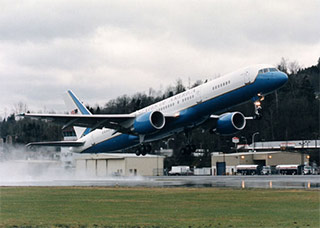
There are small aircraft, like the trainers flown by student pilots, and large aircraft sharing the same airspace. Can you think of another size aircraft that belongs on the same list?
It may not be the one that comes most readily to mind. Regardless of what size aircraft a particular pilot flies, another classification of aircraft that comes in for special attention by pilots and controllers alike is aircraft described as heavy. These terms apply to how air traffic control keeps aircraft separated to avoid wake turbulence encounters.
For wake turbulence separation purposes, ATC classifies aircraft as small, large, and heavy, explains the Aeronautical Information Manual’s Pilot/Controller Glossary. A heavy aircraft is one that is capable of takeoff weights of 300,000 pounds or more. The designation applies "whether or not they are operating at this weight during a particular phase of flight."
An aircraft is large if it has a maximum takeoff weight of more than 41,000 pounds, up to but not including 300,000 pounds. A small aircraft is one with 41,000 pounds or less maximum certificated takeoff weight, the glossary explains.
Air carriers are expected to add the word "heavy" to their call signs as appropriate when communicating with ATC. In a special case, the Boeing 757 is treated as a heavy aircraft for separation purposes because of the wake turbulence it has been found to generate.
Pilots who fly from larger airports become familiar with wake turbulence holds prescribed in AIM 7-3-9.
In ground study, you learned that all fixed-wing aircraft generate wingtip vortices, and that pilots should maintain a flight path that avoids flight in or below the zone where a preceding aircraft’s wake is likely to exist. That means learning to visualize the effect of surface wind on the location of vortices generated by aircraft that are taking off or landing.
In addition to the required separations applied by ATC, the AIM offers this tip to pilots of lighter aircraft on visual approaches to an airport where a visual approach slope indicator (VASI) or other such vertical guidance system is available: Fly at or above the indicated glidepath when proceeding in trail of an aircraft that could produce strong wake vortices.
Sharpen your knowledge of this key safety subject by taking the Air Safety Institute’s Safety Quiz "Takeoffs, Landings, and Wake Turbulence."



